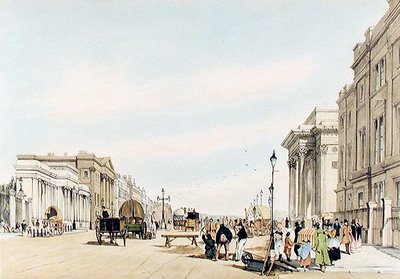
Jane Austen's characters attended assemblies, routs, and parties so often that one is left to wonder: Did these people never stay home?
When the social whirl was in full swing during the London social season, a well-connected, rich, well-born, or idle person could attend several gatherings in one night. Here is a first-hand description of an assembly by Louis Simond, a transplanted Frenchman in America, inveterate traveler, and author of An American in Regency England (p. 31):
"Great assemblies are called routs or parties; but the people who give them, in their invitations only say, that they will be at home such a day, and this some weeks beforehand. The house in which this takes place is frequently stripped from top to bottom: beds, drawers, and all but ornamental furniture is carried out of sight, to make room for a crowd of well-dressed people, received at the door of the principal apartment by the mistress of the house standing, who smiles at every new comer with a look of acquaintance. Nobody sits; there is no conversation, cards, no music; only elbowing, turning, and winding from room to room; then, at the end of a quarter of an hour, escapting to the hall door to wait for the carriage, spending more time upon the threshold among footmen than you had done above stairs with their masters. From this rout you drive to another, where, after waiting your turn to arrive at the door, perhaps, half an hour, the street being full of carriages before the house--then every curtain, and every shutter of every window wide open, shewing apartments all in a blaze of light, with heads innumerable, black and white (powdered or not), in continual motion. This custom is so general, that having, a few days agao, five or six persons in the evening with us, we observed our servants had left the windows thus exposed, thinking, no doubt, that this was a rout after our fashion."
Indeed, with such a throng of people inside an enclosed space and candles blazing on hot spring and summer nights, the rooms would have been stifling. Had the windows and doors not been kept open, the heat and lack of fresh air would have been insufferable. People often needed to step outside to the terrace or gardens to gain some relief from candle smoke, body odor, and fetid air.
As you can see from this illustration of the Assembly Room in Bath by Thomas Rowlandson, the public assemblies also provided opportunities for dancing. One must surmise that private and public assemblies differed in character. The size of a hostess's house and her budget must also have dictated whether she could also provide music and dancing at her gathering.




